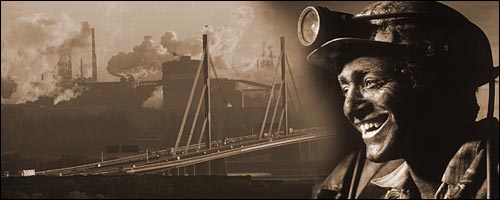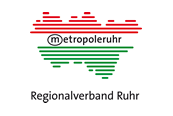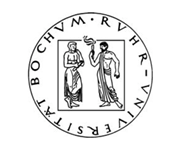Main topic: The era of the coal and steel industry

Quelle: RVR-Fotoarchiv, Kollage Autorenteam
Subtopic: The development of the coal and steel industry
When the marl layer that covers the coal seams had been penetrated in the 1830s the access to the rich coal was guaranteed. Since the middle of the 19th century the increase of the coal and steel industry has been fostered by a series of self-intensifying cause-symptom processes that resemble the Kondratieff cycles of basic technologies.
- The transfer of expertise (e.g. by industrial espionage, by acquiring licences and by foreign experts) and metallurgical innovations: Improved processes to melt steel allowed a more efficient, a cheaper and a larger production. Rolling mills produced sheet steel, the steel casting technology wheels and other cast shapes.
- Innovations of the international finance system gave birth to new company forms as e.g. stock companies; trading banks from Cologne and foreign investors put the necessary extensive means at disposal. The result was that a multitude of new companies were established in the second half of the 19th century.
- Shipping, the construction of canals and particularly the railway set a third flywheel of development in motion: They consumed steel (network extension, production of the rolling stock) opened up (labour) markets, exported steel and coal and ?imported? labour force and population.
- The scope of political actions widened as well: The small states structure disappeared, trade was more and more liberalised. Germany?s unification caused a high demand of infrastructure for trade, armed forces and administration.
- Facing the infrastructural demands the new state itself was investor and client and guaranteed permanent orders and increasing sales to major customers as Krupp, Haniel, Hoesch and Harkort.
- A growing labour force and their families, e.g. from Poland, let the urban building industry expand rapidly as well: industrial buildings, works streets and railways, pipeline systems, canals, harbours and power lines had to be built, but there was also a rapidly increasing demand for housing, schools, hospitals, traffic facilities, shops and varied services.
Subtopic: World Wars and post-war time
The two World Wars brought lows to the regional industry as armaments industry, compulsory work, destruction and reconstructions but also heydays. The coal and steel industry complex, however, had undeniably lost its power of innovation and growth already before World War II. A technological maximum had been achieved. The war economy and the post-war reconstruction phase gave additional impulses without which the complex of coal mining and steel industry would have lost its dominant influence on the regional economy already before.
This assumption is supported by the invention of the completely new steel-producing technology of the direct arc furnace that uses electricity instead of coke. New ?mini steel works? came into being that unlike the integrated steel works of the Ruhr could produce ordinary steel by increasingly using scrap and that could be established on any given site as electricity and scrap are available nearly everywhere in the world. In power stations coal was increasingly substituted by oil. Mitigated by the special post-war demands the consequences ensuing from these technological changes did manifest themselves not earlier than in the late 1950s (coal crisis) and in the 1960s/1970s (steel crises).
Subtopic: Crisis and fall of the coal and steel sector
The steel industry had to face fundamental problems as well. New technologies (constantly reduced amounts of coke in the blast furnaces, electric melting process) were to sever the locational connections of coal and steel. ?Wet smelting works? on the coast, as e.g. in the Netherlands and around Bremen, took the profits from reduced transportation costs for both coal and ore. In the Ruhr area only the ?Rhine front? in Duisburg maintained by producing highly innovative special steels whereas the world-wide unsatisfied demand for ordinary steel had been transferred into emerging countries like China, India and Brazil or to the Mediterranean coasts where a new generation of ?mini steel plants? was established.
These factors are combined into a self-supporting process of regional rebuilding and conversion that has not yet come to an end even half a century after the first coal crisis.
The industries of the Ruhr have developed from the south to the north ? from the Ruhr zone via the Hellweg zone into the Emscher and Lippe zones. The closing down of mines followed the same direction. As the deep mining collieries could produce only very expensive coal which was not competitive on the markets the Ruhr coal mining started to get subsidized. In the recent years the relative young mines in the Emscher and Lippe zones that give jobs to many thousands of workers have been affected. The once many hundreds of mines have been reduced to only four in 2011, and the last mine is due to shut down in 2018. The northern zones of the Ruhr have therefore to face the greatest challenges to overcome the structural changes. Deprived urban fabrics, unemployment, large shares of migrants, problems of integration, poverty and an insufficient degree of education are concentrated there.
Accompanied by a series of regional crises the Ruhr follows ? inevitably and delayed ? the path of structural change from an old industrial region to a society based on services.
Subtopic: Obstacles to the structural change
On the other hand, public subsidies allowed the coal mining industry to retain or ?smoothly? to melt off hundred thousands of jobs. Protected by a coalition of interests (entrepreneurs, workers/trade unions and the national/regional policy) the conversion of the ?old industrial society? into a ?new service-based society?, and finally into a knowledge-based society could therefore be arranged in quite a socially consistent way which has worldwide been accepted as a successful model.
But there are considerable costs resulting. The Ruhr has turned into an economically ?delayed region?. It has often been arduous to catch up with modern economic structures and trades that are competitive on the world market and it could only partly be achieved. ?Modern? industries as e.g. electrical industry, automobile industry, electronics/information and communication, chemical and pharmaceutical industries have earlier, more intensively and in the end successfully been established elsewhere as e.g. in southern Germany. The exceptions are the ICT and the microsystems technology in Dortmund and the Opel works in Bochum.
With the conversion of the regional coal and steel industry being hesitant and overstretched in time and embedded both into an atmosphere of subsidies and into the coalition of interests the large companies succeeded in building up promising fields and sites ? but outside the region, and increasingly abroad. The need of modernasation and the new composition of the companies systematically bore fruit outside the Ruhr area whereas the de-composition and the dismissal of workforce affected the Ruhr area.
Next to this indirect loss of innovation there were other factors that impeded and delayed the restructuring.
- The property blocking: in fear of new competitors on the labour market the regional companies retained their large properties or sold them at excessive prices. New investors were thus being kept away.
- The education blocking: Up to 1964, there was no university in an area with 5.4 million inhabitants. Since Bismarck?s times universities and students have been regarded as sources of unrest unwanted in Germany?s economic heart. In the 1970s and 1980s, when a series of universities had been founded a qualified labour market, urgently needed for the rebuilding, gradually developed.
- The lost ability of innovation: The mono-structure of the coal and steel industry requested highly specialised suppliers. In other words, the amounts and the qualities of the materials, machines and services to be delivered were precisely prescribed. Consequently, as these suppliers were but little inclined to improve and to innovate the ability of innovation could not sufficiently be developed in the small and medium-sized firms that, on the other hand, were regarded as the driving forces of structural change.
- The problem of the regional image: Up to the turn of the millennium the Ruhr has been affected by a persistent negative image concerning wages, housing conditions and leisure potentials, both investments from outside and an in-migration of highly qualified human capital remained rare exceptions.
- The missing growth impulses increased the competitive pressure on the stagnating or shrinking local communities. The struggle for jobs, local taxes and inhabitants caused a deeply rooted local egoism. Up to the present inter-communal or even regional forms of cooperation are only exceptions.
Subtopic: Population and labour
From the late 1950s to the 1980s the crises of the coal and steel industry made unemployment an increasing problem. Consequently, the younger, well-educated and active parts of the population have left the region since the 1970s. The recent population structure lacks a remarkable part of the baby boomers. Moreover, due to the birth-rate slump caused by the pill the parents of the children now missing in the region haven?t even been born. By 2030 the population of the Ruhr will have decreased by approximately half a million, with the number of persons below the age of 18 decreasing by 180,000, but that above the age of 65 increasing by 240,000.
The Ruhr will lead the way in the process of demographic change. The population will decrease, will getting older and will be ethnically more varied. Problems of integration as well as a lack of qualified workers are still today among the factors that impede the growth of the regional economy and disadvantage the region.
The changing role of women and the greater flexibility of the (working-) life are among the causes that reject the wish to have children or at least gradually delay it. With only 1.4 children per woman the population is declining by one third per generation, a quota of 2.1 children is required to maintain the number of population. Persons that descend from immigrants exhibit higher birth rates and their relative share is increasing. But the birth rates of Germans and non-Germans become more and more similar. Finally, with the life expectancy increasing the population grows older.
The shrinking of the population causes some problems:
- The economic thresholds of local services are sinking, retailers and service units will close.
- With the traffic and service infrastructure declining suburban OAP-households will move into age-adjusted flats in the vicinity of the city-centre.
- The infrastructure serving the households has to be modified, e.g. less kindergartens/schools, more pensioners? homes; churches will close.
- As the labour market is getting increasingly unattractive companies will flee from an ageing region.
- The local revenues are sinking and the local budgets are heavily indebted. The increasing need to rebuild and to converse can only be answered by a financially limited scope of actions.
- The qualities of the housing, working and leisure areas will be deteriorated, an increasing number of out-migrants and a reduced number of in-migrants will accelerate the ?circulus vitiosus?.
To the abstracts of other main chapters:
1. Fundamentals and beginnings
3. Renewing the infrastructure
4. Renewing urban areas
5. Renewing the economy
6. Perspectives for the future
1. Fundamentals and beginnings
3. Renewing the infrastructure
4. Renewing urban areas
5. Renewing the economy
6. Perspectives for the future



